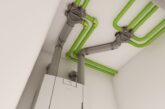
Mechanical Ventilation with Heat Recovery (MVHR) is poised to become an integral component of modern energy-efficient new builds. Professional Builder’s Lee Jones looks at the latest units from Vent-Axia.
As property owners have been acutely aware of late, considerable amounts of cash are spent on heating homes, only for a large part of that outlay to be lost through doors, windows and walls. That cycle of heating and heat loss can, however, be broken. The 2021 updates to Building Regulations made a fabric first approach more critical than ever, with enhanced levels of airtightness and lower U-values, and this will be further strengthened with the arrival of the Future Homes Standard in 2025. All that needs to be achieved without compromising air quality, of course, because the unwelcome pollutants that invade our domestic retreats from the world can have significant health implications, causing anything from headaches to fatigue and sore throats. This is where mechanical ventilation with heat recovery finds it place. By maintaining decent levels of air quality and – as the name would suggest recovering valuable warmth that would otherwise be squandered, householders can enjoy lower bills, higher levels of thermal comfort and a cleaner indoor environment.

So just how does it work?
MVHR operates on the basis of the first law of thermodynamics – that energy can neither be created or destroyed but changed from one form to another. In this way it extracts polluted indoor air, exhausting it from the building and, with the use of a counter-flow heat exchange technology, transfers that heat to fresh air coming into the building. The units are up to 93 per cent efficient, and the systems include filters that will significantly improve indoor air quality by removing dust particles, including mould spores and bacteria. Those filters can be easily removed for cleaning and there’s also a built-in sensor that will control humidity levels.
The Lo-Carbon Sentinel Econiq is Vent-Axia’s flagship residential MVHR solution and there are three units to choose from – Econiq S, Econic M and Econic L. Together they form a range that will satisfy the needs of anything from a one bed through to an eight-bed property with flow rates up to 167 l/s at 150pa. Thanks to a well-designed steel foam and expanded polypropylene (EPP) construction, the product benefits from an air leakage rate as low as 0.9 per cent, whilst specially designed mounts minimise levels of vibration.
What that means for the homeowner is radically reduced levels of sound. From just 15.5db it is, in fact, quieter than somebody whispering. The latest 2022 Part F requirements already demand that MVHR units should be designed and installed to minimise noise and, with more stringent requirements set to be introduced in 2025, the Econiq is positioned for compliance. It’s not the only regulation that the Econiq satisfies, either, because it’s also Passivhaus compatible.

The MVHR is equipped with a polymer heat exchange cell which is up to 93 per cent efficient and a fully automatic summer bypass. Here, the comfort level can be set via the onboard HMI control board or via the app and in the warmer months cooler air can be brought in when the outdoor air cools below that of the indoor air, bypassing the heat exchanger, and maintaining a liveable temperature level indoors. On the M and L models a flexible installation is afforded by ductwork that can be fitted to the side or the top of the unit and the latest in EC/DC motors makes it extremely efficient in operation.
Connectivity
The Econiq can be commissioned via the Vent-Axia Connect App and, by making use of the Part F Commissioning Wizard, a report can then be generated and supplied to Building Control. By functioning as a handy tool to determine what the house is doing, and the status of the indoor environment, the app also includes a number of end user friendly features. Levels of ventilation can be decreased or increased, for example, whilst CO2 can be monitored.
Indeed, Vent-Axia offers a range of wired and wireless – as well as battery and mains powered – sensors and controllers. These include CO2, Passive Infrared (PIR), temperature and humidity sensors which can be used in either a commercial or residential setting.
Sentinel Apex is the manufacturer’s commercial heat recovery and ventilation unit. In common with the Econiq it’s a low energy, minimal noise solution. There are five models in the range with the ventilation specialist’s online Fan Selector tool allowing the right unit to be specified for a particular building.

With the Future Homes Standard scheduled for implementation in 2025 even more attention will be placed on the energy that properties are consuming. It will demand highly efficient buildings, with low carbon heating systems, and the best fabric standards possible. At the same time a sealed building that continues to host all of the essential and everyday human activities – such as cooking and cleaning – will inevitably suffer from condensation and humidity problems, which could equally impact on occupants’ well-being. Vent-Axia Mechanical Ventilation with Heat Recovery (MVHR) mitigates against these issues – and therein lies the future-proofing inherent in the technology.
The three pillars on which Vent-Axia products stand are indoor air quality, low carbon and thermal comfort. With buildings responsible for 40 per cent of emissions globally, levels of insulation and airtightness are set on a relentless path of improvement. It then follows that MVHR systems will no longer be an option but an integral component of a whole house system.
For further information on Vent Axia’s Mechanical Ventilation and Heat Recovery (MVHR) solutions visit Mechanical Ventilation with Heat Recovery | Vent-Axia.







